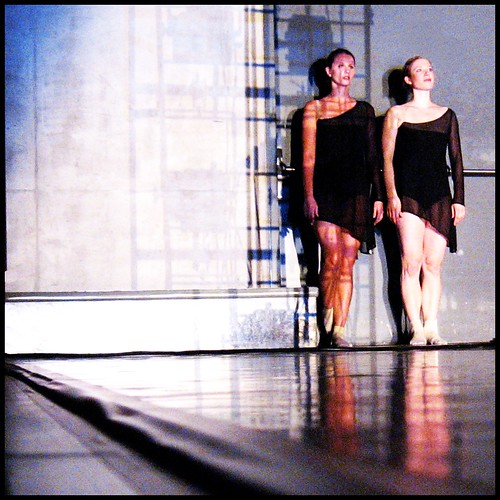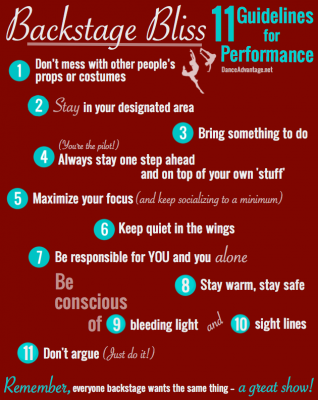Whether it is your first recital or your fourteenth, it never hurts to be reminded about proper backstage etiquette and behavior.
Your studio owners and teachers may have specific regulations and procedures for you to follow. Adhering to these rules helps the performance to run smoothly for you and the others around you. Recitals can be hectic and stressful for those trying to make the day/evening go off without a hitch. I know your teachers will appreciate not having to remind you or your friends of these basics on recital day.

1. Don’t mess with other people’s props or costumes
This is a top directive of any backstage situation. Playing with or moving someone else’s props or costume pieces always results in one of the following: A) items will not be in the correct place when they are needed, stalling the show or leaving someone without, B) items get broken, torn, damaged, stalling the show or leaving someone without, C) someone being rather upset with you. If the prop or costume is not yours, don’t touch it! Even if you think it’s in the wrong place and are trying to help, you should just tell the person to whom it belongs or an appropriate adult.
2. Stay in your designated area
I know it can be annoying to be restricted as to where, when, or how you can go somewhere, especially when you are quite familiar with the building or backstage area. It can also be tempting to want to move from your green room (or waiting area) if your friends are required to be in another location. However, it is important to stay where you are supposed to be throughout the recital process. Why? Teachers and recital helpers have a lot of kids to keep track of during a performance. When their requests are ignored, you stand the chance of missing your entrances or causing someone else to miss theirs. Even worse, is that no one knows where to look for you should something unfortunate occur.

3. Bring something to do
Recital performances almost always involve a lot of waiting either during dress rehearsal or on show days or both. Even if you think you’ll be busy, it’s always a good idea to bring something quiet to do backstage as you wait (in your designated area). Some possibilities include a book, a simple card game, pens and paper, coloring books and crayons, puzzle books, even a hand-held video game if the sound can be turned off. It is alright to play games with friends as long as you can keep the noise levels down. Just make sure you are ready and in your next costume before engaging in an activity, and that you can drop what you’re doing immediately when asked to go.
4. Always stay one step ahead and on top of your own ‘stuff’
You’re piloting your own plane — be responsible for yourself. Don’t rely on others to know what’s next, know where you are supposed to be, or what you have to do – not if you don’t have to or are old enough to do it yourself, anyway. This involves laying out your costumes ahead of time and knowing what order they go on, keeping track of where your dances are in the performance (and what’s before them), knowing what hair or makeup changes are made and when, being sure about which side of the stage you enter from, double checking that you have all you need before you leave the house.
5. Maximize your focus and keep socializing to a minimum
There’s a lot of energy in the atmosphere at a performance. It is easy to get caught up in the excitement with your friends backstage, allowing noise levels to escalate and/or creating a distracting environment for yourself or others. To have the best show possible it is important that everyone stay calm and focused. After a successful show is the appropriate time to party. During the show choose calm activities (see #3) to occupy yourself and your friends and reserve your energy for your performance onstage.
6. Keep quiet in the wings
The immediate backstage area is not the place to go over choreography, have a conversation, or ask a question. Sound from backstage can carry surprisingly well to the “house,” or audience. If you are prepared, calm, and focused there should be no reason for talking in the wings. If a peer asks you a question, nod (if the answer is yes or no), and/or calmly remind them to be quiet with the universal symbol at left. Making noise in order to quiet others is not only unhelpful, it doesn’t make much sense! Which leads me to…
7. Be responsible for you and you alone
Unless you are specifically put in charge of a person or group, allow a teacher or someone in authority to take care of any disorderly students. If you know that someone missed being given an important direction, for example, when it is time to line up, calmly let them know and then move along yourself. Don’t waste time helping those who are not helping themselves because your only job is to be responsible for you. When you occupy yourself with what others are or are not doing, you risk missing your own cues, entrances, costume changes, etc.
8. Stay warm, stay safe
It is important to stay safe and free of injury backstage. If you know you have some downtime between numbers, wear a warm-up and/or legwarmers over your next costume (just remember to take them off!), staying active and mobile with full-body movements like noiseless jumping jacks or body swings, and doing some stretching to keep your body warm and limber while you wait. Other safety measures include not wearing soft shoes or bare feet in areas that have not been swept clear (especially in the immediate backstage area where often there can be shards of wood or glass, or things lying about from other performances). Your teachers will let you know if an area is safe to be barefoot but wear shoes/flip-flops if you are going to be moving about backstage in zones that may not have been cleared.
9. Be conscious of bleeding light
This is one that even those helping at a recital sometimes forget. If you’ve ever stood in a dark room when someone opens the door to a room that is lit, you understand that light has a way of “bleeding” into the darkness. This is why it is kept dark in the backstage area with only blue or other filtered lights illuminating the area. Being conscious of this means waiting until someone from the inside (who knows when it is “safe”) opens a door to the backstage area, or listening for the appropriate time yourself. Typically when you know that the dancers onstage are performing and being lit, it is safe to enter but do so quickly, quietly, and close the door behind you. Any light from backstage can affect the lighting design onstage.
10. Be conscious of sight lines

This is another one of which novices to the stage may not be aware. Sight lines are imaginary lines that distinguish what is visible to the audience and what is not. A good rule of thumb is that if you can see an audience member, they can see you. However, you must be aware of your whole body, not just your eyes. When waiting in the wings, it is a good idea to stand close to the curtain (without moving it) and back from the very edge. Some studio owners will place a line of tape for students to stand within or behind when waiting backstage. Though it can be tempting to try to see everything happening onstage, stay out of the audience’s line of sight. If your cue for entering cannot be seen from where you are waiting, dress rehearsal is the time to figure out a new cue!
11. Don’t argue
Last but not least, it is important to be courteous and respectful toward others, especially during a performance. This includes the teachers, parents, and others who are helping backstage at a recital. By showtime you should know (by face, name, or by an identifying badge or button) teh people who have been designated as helpers and what role they play in helping the performance to run smoothly. If you are instructed to do something or go somewhere, asked to quiet down, or are otherwise asked to respond to a request – just do it! Don’t question, don’t argue, don’t grumble.
If you happen to be absolutely positive that you are being misdirected, ask nicely to check the facts – “I am sure that I am to be in Room C, not Room A right now. Can we double check, just to be sure, please?” People’s patience can run thin during a high-stress situation like a performance. If your respectful response is not appreciated, don’t react. Simply do your best to comply with the direction given.

For those of you who still have recitals ahead, I hope that this list will come in handy. Remember that everyone backstage at a performance wants the same thing – a great show that runs smoothly and is fun for the audience and participants. Though the show’s organization may not be something you can control, you still have the power to make sure you are fulfilling your role to the best of your ability. Following these eleven rules of thumb will help to ensure that.
Have a great performance!

What are some other things students should do or remember when they are backstage?
What are some things your studio does to keep things running smoothly at a performance?
Nichelle Suzanne is a writer specializing in dance and online content. She is also a dance instructor with over 20 years experience teaching in dance studios, community programs, and colleges. She began Dance Advantage in 2008, equipped with a passion for movement education and an intuitive sense that a blog could bring dancers together. As a Houston-based dance writer, Nichelle covers dance performance for Dance Source Houston, Arts+Culture Texas, and other publications. She is a leader in social media within the dance community and has presented on blogging for dance organizations, including Dance/USA. Nichelle provides web consulting and writing services for dancers, dance schools and studios, and those beyond the dance world. Read Nichelle’s posts.

